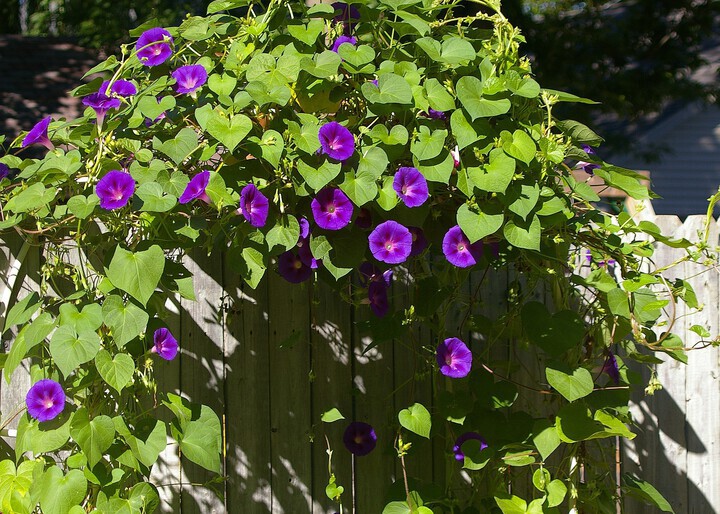How do you plant and care for morning glories? These strong climbers have beautifully-shaped blooms that unfurl in the sun and romantic tendrils that lend old-fashioned charm. Learn more about growing morning glories.
ABOUT MORNING GLORIES
Morning glories bloom from early summer to the first frost of fall. With slender stems and heart-shaped leaves, their trumpet-shaped flowers come in colors of pink, purple-blue, magenta, or white. Their fragrant, colorful flowers are not only attractive to our eyes but also beloved by butterflies and hummingbirds.
Train twining morning glory vines over a pergola or arch, or use as a dense groundcover. This drought-tolerant plant grows quickly—up to 10 feet in one season—and can self-seed fairly easily, too. Because of this, you’ll want to choose where you put this plant wisely! Otherwise, you may end up with more morning glories than you bargained for.
Warning: Morning glory seeds are poisonous, especially in large quantities. Keep them out of reach of children and pets. Learn more.
WHAT’S THE DIFFERENCE BETWEEN MORNING GLORY AND BINDWEED?
The attractive annual morning glory (Ipomoea spp.) is often mistaken for its perennial cousin, field bindweed (Convolvulus arvensis), which is an aggressive, invasive weed native to Europe and Asia. Field bindweed—also called “perennial morning glory” or “creeping jenny”—grows similarly to annual morning glories, but sends out deep, deep roots, which make it very difficult to get rid of and allow it to overwinter in areas where cultivated morning glories could not.
To tell the difference between the plants, look closely at the leaves, flowers, and vines:
Field bindweed leaves are typically smaller than those of annual morning glories. Morning glory leaves may be 2 inches or more across; bindweed leaves rarely exceed 2 inches. Bindweed leaves are also shaped more like an arrowhead than those of morning glories, which are heart shaped.
Field bindweed flowers only occur in either pink or white, whereas annual morning glory flowers may be pink, white, magenta, blue, purple, or red, and are much larger than those of the bindweed.
Morning glory vines are usually thicker than bindweed’s vines, and typically have small hairs.
In any case, if you come across a plant in your garden that resembles morning glory and you know you didn’t plant it, it’s best to err on the side of caution and treat it as a weed.
PLANTING
WHEN TO PLANT MORNING GLORIES
Sow morning glory seeds in late spring or early summer, once the ground has warmed to about 64°F (18°C).
CHOOSING AND PREPARING A PLANTING SITE
Grow morning glories in a sunny spot. They need a lot of sun to bloom their best!
Plant in moderately fertile, well-drained soil.
Choose a site that is sheltered from strong, drying winds.
Give them a fence, lattice, or trellis to climb.

HOW TO PLANT MORNING GLORIES
Germination rates are improved by filing down the seeds just enough to break the coat, then soaking them for 24 hours before planting. This encourages them to send out a root (it looks like a little worm).
Cover lightly with ¼-inch of soil. Space seeds about 6 inches apart.
Water thoroughly at planting.
Seedlings should appear in about a week.
CARE
GROWING MORNING GLORIES
Apply a balanced liquid fertilizer after planting. Do not over-fertilize, or the vine may grow more foliage than flowers.
Support this climbing plant with structures like trellises, pergolas, or arches.
Tip: Morning glories climb by twining their vines (like peas or beans) around a support, so make sure that whichever type of structure you grow them against has plenty of space for whorling!
Morning glories are low-maintenance; just be sure to water during dry periods.
Mulch to retain moisture and suppress weeds.
If you don’t want the plant to reseed itself, just snip off old flowers before they turn into seedpods.

PESTS/DISEASES
Pests:
Morning glories are fast growing and are rarely bothered by pests to a significant extent. However, the following pests may be seen feeding on the vines:
Aphids
Leaf miner
Spider mites
Caterpillars (leaf cutters)
Disease/Fungus:
Rust
Fungal leaf spots
Fusarium Wilt
RECOMMENDED VARIETIES
‘Heavenly Blue’ are the classic morning glories with the rich azure (blue) flowers with white throats. It climbs to 12 feet.
‘Scarlett O’Hara’ has bright red flowers with a white throat. It climbs to 15 feet.
Here are more recommended morning glory varieties!

WIT & WISDOM
Morning glories are one of September’s birth flowers.
If you’ve ever grown sweet potatoes, you may notice a resemblance between their leaves and flowers and those of the morning glory. Unsurprisingly, the plants are related: both belong to the genus Ipomoea.